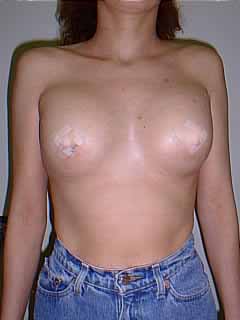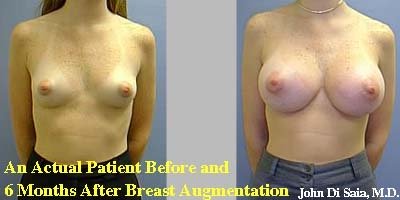Implanted breasts undergo an evolution
of sorts following surgery. The body adjusts to hosting the implant and this adjustment can change over the years that follow. There are also events of which the patient may have control that have predictable changes in an implanted breast. When I tell patients this prior to surgery, many of them look at me with surprise, so it seems like a good topic for discussion. Realistic expectations are important to establish again BEFORE
AN OPERATION.
Breast implants themselves do not change much after placement, but the tissues around them do. Breast implants are new volumes placed under the skin, breast and (most often) pectoral muscle. It naturally follows that the body will have to adjust to them. How the body adjusts however is (like most issues in surgery) variable. There are some generalizations that are pertinent here.
The Early History Of The Implanted Breast - "Dropping and Fluffing"
For young patients without much breast tissue or skin (young and haven't had children and breast fed), the breast appears full just following surgery. The chest skin and pectoralis muscle are stretched by the new implant. My patient below appears one day from the operation at which time moderate sized implants were placed beneath her pectoral muscles. (Her nipples and some steristrips were "Photoshopped") Notice the full area above the nipples and the general appearance of "tightness." The breast almost looks upside down at first. Remember she is only one day out.

This appearance changes substantially over time. The implant will "drop" to a degree and the fullness in the upper breast region will descend towards the lower breast. The degree to which this will occur depends upon the elasticity of the skin and muscle of the chest wall as well as the size of the implant placed. This process has been referred to as "Dropping and Fluffing" and can take several months after surgery to be completed. One of the reasons Dr Di Saia follows his breast implant patients for months after surgery is to help them through this sometimes troubling time. Of course when the operation is done more carefully this period tends to be shorter. :)
Let's Talk "Time Line"
The breast just following implantation is swollen (further contributing to the "perky" appearance). This swelling normally resolves over the first two to three weeks. Many patients don't like this decrease in swelling ("makes the breasts look like they are shrinking!"). The resolution of the operative swelling is associated with a softening of the breast as well. As the tissues soften [ "Fluffing,"] the breasts may appear to increase in size again with the same implants in place. Less compression on those implants by the newly relaxed tissues means the same sized implants can look bigger. This usually takes several months.
In these same months, the body figures out that the breast implants are foreign material. It begins a process of isolating it from the rest of the body. A capsule of scar tissue is formed. This capsule is composed of collagen and can be soft and pliable or more firm. "We want soft."
Some capsules end up being so thin you can see through them and others are more firm. They usually differ somewhat from side to side. In my practice, we encourage breast massage and saline sub-muscular implants. This and our own technique has worked to reduce the incidence of firm capsules to almost none.
These scar capsules (one around each implant) when firm can exert force upon the implants which can make the breasts feel firm or distorted. In these cases, more surgery to soften them is in order. This happens more commonly in smokers and those with silicone gel and/or large implants.
Post-Implantation changes
(1) Swelling resolves over first few weeks (for moderate sized implants) resulting in softening and slight decrease in size.
(2) Implants "settle" over first 3-6 months descending (usually) to a more natural position. The tissues soften and the implants may look bigger ["Dropping and Fluffing"]
(3) The implant's presence will cause the body to produce a capsule around it. This begins to form soon after implantation. Most of these (thankfully) are soft, but infrequently (2%) they may become firm and uncomfortable. Most firm capsules seem to form in reconstructive patients (after mastectomy), when silicone implants are used or in cases involving hematoma or infection. The degree to which a capsule forms has a lot to do with the genetics of the patient and the geometry of the chest and implant.
The good news here is that most patients are quite happy with their implants.
A study printed in a 1994 issue of Aesthetic Plastic Surgery (a medical journal) addressed patient satisfaction with breast augmentation. The author found that 95% of patients felt that the operation met their expectations. 86% reported that they were completely or mostly satisfied with the results. Finally, 81% of the patients stated that they would have the operation again. Below is an example of one of my patients before and 6 months after her breast augmentation procedure.

BREAST MAIN | SITE MAIN
© John Di Saia, MD... an Orange County
California Plastic Surgeon
Serving Southern California since 1997 * (949) 369-5932
|

